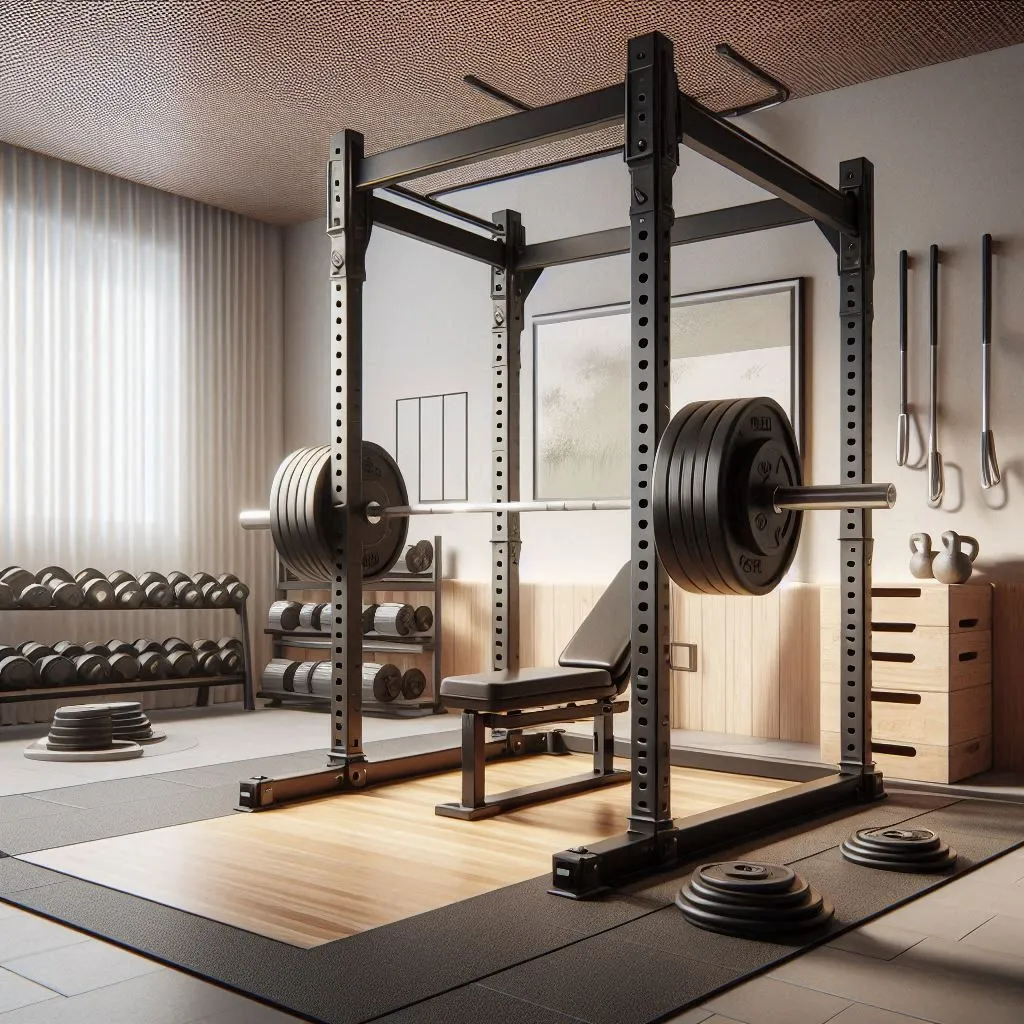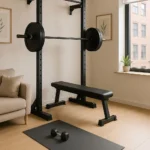Introduction: Building Strength in Your Own Space
Are you tired of waiting for equipment at crowded commercial gyms? Looking to build serious strength without the monthly membership fees? The 5×5 workout might be exactly what you need—and the best part is you can do it right at home in your garage gym.
The 5×5 workout has stood the test of time as one of the most effective strength training protocols ever created. With just five basic compound exercises performed for five sets of five repetitions, this minimalist approach delivers maximum results. And contrary to popular belief, you don’t need an expensive gym membership to reap these benefits.
Home training has exploded in popularity, with more fitness enthusiasts discovering the convenience, privacy, and long-term cost savings of garage gyms. When combined with the structured progression of a 5×5 program, your home gym becomes a personal strength sanctuary where serious gains happen.
This comprehensive guide will walk you through everything you need to know about implementing the 5×5 workout at home—from essential equipment and proper form to progression strategies and troubleshooting common challenges. Whether you’re just starting your strength journey or looking to optimize your existing home setup, you’ll find practical, actionable advice to maximize your results.
Understanding the 5×5 Workout Framework
The Core Principles of the 5×5 Workout Method
The 5×5 workout isn’t a modern invention—it’s a time-tested approach with roots dating back to the 1950s when Reg Park, a three-time Mr. Universe and mentor to Arnold Schwarzenegger, popularized it. Later, strength coaches like Bill Starr, Mark Rippetoe, and Mehdi Hadim created their own variations, bringing the method to mainstream fitness culture.
At its core, the 5×5 workout revolves around a simple yet profound concept: perform five sets of five repetitions across major compound movements. This specific rep range strikes the perfect balance between strength development and sufficient volume. By working in the 5-rep range with challenging weights, you stimulate both neural adaptations for strength and muscular hypertrophy for size gains.
The most popular 5×5 variations include:
- StrongLifts 5×5: Features squats every workout with alternating upper body movements
- Madcow 5×5: An intermediate progression with ramping sets to a top weight
- Starting Strength: While technically a 3×5 program, it follows similar principles and can be modified to a 5×5 format
What makes the 5×5 workout particularly effective is its emphasis on progressive overload—adding small amounts of weight consistently—which forces your body to continually adapt and grow stronger.
Key Benefits of the 5×5 Workout for Home Trainers
The 5×5 workout is uniquely suited for home training environments for several reasons:
Efficiency: Complete workouts typically take 45 minutes or less, perfect for fitting into busy schedules without commute time to a commercial gym.
Simplicity: The program uses just five basic exercises with a straightforward progression pattern—ideal when you’re self-coaching at home.
Equipment Minimalism: You only need a barbell, weights, and some form of rack, making it economical for home gym setups.
Whole-Body Development: The compound movements target multiple muscle groups simultaneously, eliminating the need for numerous isolation exercises and machines.
Measurable Progress: The clear progression metrics of the 5×5 workout keep you motivated when training alone, as you can see your strength increasing week after week.
Scalability: Whether you’re a novice lifter or more experienced, the 5×5 approach can be adapted to your current strength level and equipment availability.
Essential Exercises in the Home 5×5 Program
The 5×5 workout revolves around five fundamental compound movements that collectively train your entire body:
Squat: The king of exercises targets your quadriceps, hamstrings, glutes, and core while stimulating whole-body strength development. In most 5×5 variations, you’ll squat 2-3 times per week.
Bench Press: This upper-body push movement primarily develops your chest, shoulders, and triceps. When performed with proper form, it’s one of the most effective exercises for upper body strength.
Deadlift: Perhaps the ultimate test of total-body strength, the deadlift works everything from your fingers to your neck, with particular emphasis on the posterior chain—hamstrings, glutes, and back.
Overhead Press: Also called the military press, this exercise builds shoulder strength, upper chest, and triceps while challenging core stability.
Barbell Row: The primary pulling movement in the 5×5 program, barbell rows develop a strong back, improve posture, and balance the pushing exercises in the program.
These exercises are typically arranged in an alternating A/B workout pattern, with squats featured in both workouts. This ensures adequate recovery while still providing enough stimulus for consistent strength gains.
Setting Up Your Home Gym for 5×5 Success
Essential Equipment for the Home 5×5 Workout
One of the most attractive aspects of the 5×5 workout for home trainers is its minimal equipment requirements. Here’s what you’ll need to get started:
Barbell: Invest in a quality Olympic barbell (typically 7 feet long, weighing 20kg/45lbs). While premium bars can cost $300+, there are decent options in the $150-200 range for beginners.
Weight Plates: Start with enough weight to challenge yourself plus room to grow. For most beginners, 150-200 pounds of plates is sufficient initially. Consider bumper plates if noise is a concern in your home setting.
Power Rack or Squat Stands: Safety is paramount when lifting heavy without a spotter. A power rack with safety pins is ideal, but squat stands with spotting arms can work for those with space or budget constraints.
Bench: A sturdy flat bench is necessary for the bench press. Adjustable benches offer more versatility but aren’t strictly required for the basic 5×5 program.
Flooring: Protect your garage floor and reduce noise with rubber mats or dedicated gym flooring. Horse stall mats from agricultural supply stores offer an economical solution at roughly $40-60 per 4’x6′ mat.
Budget-friendly alternatives when starting out:
- Consider used equipment from marketplace sites or fitness equipment resellers
- Look for package deals on barbell and plate sets
- Start with a half rack if a full power rack won’t fit your space
- Gradually add weight plates as you get stronger rather than buying everything upfront
Optional accessories that enhance your 5×5 experience:
- Fractional plates (0.5-2.5 lb plates) for micro-progression
- Barbell collars for secure weight loading
- Chalk for improved grip
- Weightlifting belt for heavier lifts
- Resistance bands for warm-ups and mobility work
Creating the Optimal Training Environment
Your home gym environment significantly impacts your training consistency and performance. Here’s how to optimize your garage for 5×5 success:
Safety Considerations:
- Ensure at least 1-2 feet of clearance around your workout area
- Check that your power rack is properly assembled and stable
- Position your equipment on level ground
- Learn proper bail techniques for each lift when training alone
- Consider a home gym buddy system for your heaviest workouts
Temperature and Ventilation:
- Install a fan or portable air conditioner for summer months
- Use a space heater during winter (keeping it safely away from movement areas)
- Consider insulating garage doors and walls for climate control
- Create cross-ventilation with open doors or windows when possible
Floor Protection and Noise Reduction:
- Cover your lifting area with 3/4-inch rubber mats
- Use silicone barbell collars instead of metal ones
- Consider building or purchasing a deadlift platform with sound dampening layers
- Implement controlled lowering of weights rather than dropping when possible
- Schedule workouts at times considerate to household members and neighbors
Lighting and Motivation:
- Install bright, overhead LED lighting to prevent lifting in shadows
- Place a large mirror on one wall to check form (if space allows)
- Create a dedicated area for your workout log or digital device
- Consider weather-resistant Bluetooth speakers for training motivation
- Personalize your space with motivational elements that inspire consistency
A well-planned garage gym creates an environment where you can focus entirely on executing your 5×5 workout with intensity and proper form, without distractions or environmental challenges.
Executing the Perfect 5×5 Workout at Home
The Standard 5×5 Workout Schedule for Home Training
Most 5×5 programs follow an alternating A/B workout pattern performed three times per week. Here’s a typical schedule adapted for home training:
Workout A:
- Squat: 5 sets of 5 reps
- Bench Press: 5 sets of 5 reps
- Barbell Row: 5 sets of 5 reps
Workout B:
- Squat: 5 sets of 5 reps
- Overhead Press: 5 sets of 5 reps
- Deadlift: 1-5 sets of 5 reps (varies by program)
Weekly Schedule Example:
- Monday: Workout A
- Wednesday: Workout B
- Friday: Workout A
- Monday: Workout B (alternating continues)
When training at home without a spotter, consider these adjustments:
- Use safety pins set at the appropriate height for squats and bench press
- Master the “roll of shame” technique for failed bench press attempts
- Consider using an RPE (Rate of Perceived Exertion) of 8-9 rather than grinding out absolute max efforts when alone
- Take extra care with proper warm-ups when training solo
Rest periods between sets typically range from 2-5 minutes, with heavier sets requiring longer recovery. When working out at home, use a timer app to keep your rest periods consistent and avoid the distraction of household tasks between sets.
Proper Warm-Up Protocols for Home Lifters
An effective warm-up is crucial for performance and injury prevention, especially when training at home without professional supervision:
General Warm-Up (5-10 minutes):
- 3-5 minutes of light cardio (jumping jacks, jump rope, or stationary bike)
- Dynamic mobility focusing on joints involved in that day’s workout:
- Hip circles, leg swings, and bodyweight squats before lower body work
- Arm circles, scapular rotations, and push-up variations before upper body work
- Cat-cow stretches and gentle trunk rotations for spine mobility
Specific Warm-Up (10-15 minutes): For each main exercise, perform warm-up sets with increasing weight:
- 2×5 with empty bar
- 1×5 with 40% of working weight
- 1×3 with 60% of working weight
- 1×2 with 80% of working weight
- Begin working sets with 100% of target weight
This progressive approach raises your core temperature, rehearses movement patterns, and prepares your neuromuscular system without fatigue.
Home training tip: Record your warm-up weights in your training log to streamline future sessions and ensure proper preparation.
Form and Technique: Self-Coaching at Home
Without a coach providing real-time feedback, home lifters must be especially vigilant about technique:
Video Analysis: Set up your smartphone on a tripod or stable surface to record your lifts from both side and front angles. Review between sets or after your workout to catch form issues.
Common Form Checks for Each Lift:
- Bar positioned across upper traps (high bar) or rear delts (low bar)
- Feet shoulder-width or slightly wider
- Knees tracking in line with toes
- Proper depth (hip crease below top of knee)
- Neutral spine maintained throughout
- Equal weight distribution between forefoot and heel
- Shoulder blades retracted and depressed
- Feet firmly planted on floor
- Appropriate arch in lower back
- Bar path moving in a slight diagonal from lower chest to over shoulders
- Wrists straight, not bent back
- Even lockout with both arms
- Mid-foot under bar at setup
- Shoulders slightly ahead of bar before lift
- Back flat, not rounded
- Bar remaining close to body throughout movement
- Hips and shoulders rising at same rate initially
- Full hip extension at top
Overhead Press:
- Bar resting on front delts at start
- Elbows slightly ahead of bar in bottom position
- Bar path allowing nose to clear by slight head movement
- Full lockout with ears visible in front of arms at top
- Core tight throughout movement
Barbell Row:
- Hinge at hips with flat back
- Eyes focused ahead to maintain proper neck position
- Bar pulled to lower ribcage
- Elbows tucked, not flared
- Minimal body English/cheating the weight up
Creating a form checklist for each lift and reviewing it before your workout can help reinforce proper technique when training alone.
Progressing with the 5×5 Workout at Home
Loading Strategies and Weight Progression
The heart of the 5×5 workout is progressive overload—consistently adding weight to force adaptation. For home training, follow these loading principles:
Starting Weights:
- Squat: Begin with 50% of your bodyweight
- Bench Press: Start with 50% of your squat weight
- Deadlift: Begin with the same weight as your squat or slightly heavier
- Overhead Press: Start with 30-40% of your bench press weight
- Barbell Row: Begin with approximately the same as your bench press
If you’re completely new to these movements, start even lighter to master technique before adding significant weight.
Standard Progression:
- Add 5 pounds per workout to squat and deadlift
- Add 2.5 pounds per workout to bench press, overhead press, and row
This approach is sustainable for beginners for 2-3 months before adjustments become necessary.
Microloading for Home Gyms: Commercial gyms rarely have increments smaller than 2.5 pounds, but home gyms can utilize fractional plates for more gradual progression:
- Purchase 1-pound and 0.5-pound plate pairs
- Make DIY fractional plates using washers from hardware stores
- Use magnetic microplates that attach to the ends of barbells
This allows for 1-pound jumps on pressing exercises when 2.5-pound increases become too difficult, extending linear progression.
Plateau Strategies for Home Lifters:
- Deload by reducing weight by 10-15% for a week before building back up
- Implement a light-medium-heavy rotation across your three weekly workouts
- Adjust your caloric intake to support strength gains
- Evaluate and improve sleep quality and recovery practices
- Consider adding an extra rest day when workouts become very demanding
Tracking Your 5×5 Workout Progress
Detailed tracking is essential for the home 5×5 lifter, as it provides objective feedback and motivation when training alone:
Digital Tracking Options:
- Dedicated strength training apps like Strong, Stronglifts, or FitNotes
- Spreadsheet templates with built-in progression calculations
- Fitness watches that include strength training modes
Analog Methods:
- Hardcover training journal with structured workout templates
- Wall-mounted whiteboard for recording weights and noting form cues
- Progress calendar marking personal records and milestones
Key Metrics Beyond Weight:
- Rating of Perceived Exertion (RPE) for each set
- Recovery quality between workouts
- Form notes and technical improvements
- Rest time required between sets
- Body measurements at regular intervals (optional)
- Progress photos every 4-6 weeks (optional)
Visual Progress Tracking:
- Create a simple graph showing key lifts over time
- Use a dedicated gym “PR board” in your garage
- Take monthly videos of key lifts to see technical improvements
Regular review of your training data helps identify patterns that might not be apparent day-to-day, such as exercises that consistently stall or particular workout days that underperform.
Adapting the 5×5 for Different Fitness Levels
The beauty of the 5×5 workout is its adaptability across experience levels:
Beginner Modifications (0-6 months of training):
- Start with 3×5 instead of 5×5 for the first 2-4 weeks to manage soreness
- Practice technique with goblet squats before barbell squats if needed
- Consider push-ups as a bench press precursor if pressing strength is very low
- Use Romanian deadlifts to build posterior chain strength before full deadlifts
- Progress weight weekly rather than every session if recovery is challenging
Intermediate Adjustments (6 months-2 years):
- Transition to weekly weight increases rather than per-session
- Implement 3×5 for deadlifts to manage fatigue
- Consider ramping sets (ascending weights across the 5 sets)
- Add light recovery days between heavy sessions
- Incorporate backoff sets (reduced weight for additional volume after main sets)
Advanced Variations (2+ years of consistent training):
- Periodize intensity with light (80%), medium (90%), and heavy (100%) days
- Add controlled accessory work for lagging muscle groups or sticking points
- Implement strategic deloads every 4-6 weeks
- Consider block periodization approach with hypertrophy and strength phases
- Use specialty bars (safety squat bar, Swiss bar) if available for your home gym
Age-Specific Considerations:
- Younger lifters (teens-20s): Emphasize perfect technique before maximal loading
- Middle-aged lifters (30s-40s): Additional warm-up time and recovery between sessions
- Masters lifters (50+): Consider 3×5 format with additional recovery days
Remember that the best program is one you can follow consistently. Adapt the 5×5 framework to fit your recovery ability, available time, and equipment without compromising its core principles.
Nutrition and Recovery for 5×5 Home Training Success
Fueling Your 5×5 Workout Progress
Even the perfect training program will stall without proper nutritional support. The 5×5 workout is demanding and requires strategic fueling:
Caloric Requirements:
- For strength gains with minimal fat gain: 200-300 calories above maintenance
- For maximum strength gains accepting some fat gain: 500 calories above maintenance
- To maintain strength while losing fat: Small deficit (300-500 calories) with higher protein
Protein Intake:
- Aim for 0.8-1g of protein per pound of bodyweight daily
- Distribute protein intake across 3-5 meals for optimal muscle protein synthesis
- Include a protein-rich meal within 2 hours after training
Meal Timing Around Home Workouts:
- Pre-workout (1-2 hours before): Easily digestible carbs and moderate protein
- Post-workout (within 1 hour): Protein (25-40g) and carbohydrates to replenish glycogen
- Training fasted can work for some but may compromise performance for others
Hydration for Garage Gym Training:
- Drink 16-20oz of water 2 hours before training
- Sip 7-10oz every 10-20 minutes during training
- Consume 16-24oz for every pound lost during exercise (especially important in non-climate-controlled garage gyms)
- Consider electrolyte supplementation during hot weather training
Strategic Supplements for 5×5 Strength Gains:
- Creatine monohydrate: 3-5g daily for enhanced strength and power output
- Protein powder: Convenient for meeting daily protein targets
- Caffeine: 100-300mg pre-workout can improve strength performance
- Vitamin D: Particularly important for home trainers with less regular sun exposure
- Magnesium: Supports muscle function and recovery, especially during intensive training
Remember that supplements are just that—supplemental to a solid nutrition foundation.
Recovery Strategies for the Home Gym Lifter
The 5×5 workout places significant demands on your recovery systems. Optimize these factors for consistent progress:
Sleep Optimization:
- Aim for 7-9 hours of quality sleep per night
- Maintain consistent sleep/wake times even on non-training days
- Create a sleep-promoting environment: dark, cool room; limited screen time before bed
- Consider tracking sleep quality alongside your workout performance
Active Recovery Between Sessions:
- Light walking on rest days promotes circulation without taxing recovery
- 10-15 minutes of mobility work focusing on tight areas
- Gentle stretching for particularly tense muscle groups
- Foam rolling or lacrosse ball self-myofascial release for problem areas
DIY Recovery Tools and Techniques:
- Ice packs for acute soreness or inflammation
- Epsom salt baths for general muscle relaxation
- Compression gear during extended sitting periods
- Contrast showers (alternating hot and cold) to stimulate circulation
- Proper cool-down after workouts with gradually decreasing intensity
Managing Fatigue Signals:
- Track morning resting heart rate—elevations of 5+ BPM may indicate accumulated fatigue
- Use grip strength as a nervous system fatigue indicator
- Monitor motivation levels and perceived exertion during warm-up sets
- Be willing to make session-day adjustments based on recovery status
- Consider implementing a subjective readiness score (1-10) before workouts
Remember that recovery happens between workouts—that’s when you actually get stronger. The workout provides the stimulus, but adequate recovery allows adaptation.
Overcoming Common 5×5 Home Workout Challenges
Troubleshooting Stalled Progress
Even with perfect execution, everyone encounters plateaus. Here’s how to address them as a home lifter:
When and How to Deload:
- Planned deload: Reduce weight by 10-15% every 4-6 weeks preventatively
- Reactive deload: When you fail to complete all prescribed reps for 2-3 consecutive workouts
- During deload weeks, maintain intensity but reduce volume (3×5 instead of 5×5) or reduce weight but maintain volume
Form Reassessment Protocol:
- Video your lifts from multiple angles
- Compare to reference videos or previous footage of successful lifts
- Look for technical changes that occurred as weights increased
- Return to submaximal weights to reinforce correct patterns
- Gradually build back up with renewed technical focus
Alternative Progression Methods:
- Double progression: Keep weight constant until you can complete all sets with perfect form, then increase
- Volume progression: Add a 6th set before increasing weight
- Density progression: Reduce rest periods gradually before adding weight
- Tempo manipulation: Add a slow eccentric phase to increase time under tension
Injury Prevention Strategies:
- Implement regular movement screening to identify asymmetries
- Add targeted prehabilitation exercises for vulnerable areas
- Consider cycling variations of the main lifts periodically to prevent overuse
- Recognize warning signs like joint pain versus normal muscle soreness
- Don’t hesitate to take extra rest days when truly needed
Maintaining Motivation Without Gym Community
The isolation of home training can challenge motivation. Combat this with:
Creating Accountability:
- Share weekly goals and results with an online lifting community
- Use habit tracking apps with reminders and streaks
- Schedule virtual training sessions with friends following the same program
- Post progress updates on fitness-focused social media accounts
- Consider friendly competition through online strength challenges
Compelling Goal Setting:
- Set both process goals (perfect attendance for a month) and outcome goals (300lb squat)
- Break larger goals into smaller milestones with specific rewards
- Create a visual goal tracker in your garage gym
- Take progress photos monthly to visually document changes
- Register for future strength events or competitions as motivation
Building a Virtual Support Network:
- Join online forums specific to home gym training
- Participate in 5×5 program-specific communities
- Follow home gym influencers for ideas and inspiration
- Create or join a messaging group with like-minded lifters
- Share home gym setup improvements and programming tweaks
Celebration Strategies:
- Create a PR (personal record) ritual to mark significant achievements
- Document strength milestones on a dedicated gym wall or board
- Plan non-food rewards for reaching major goals
- Take benchmark videos to compare against future progress
- Share achievements with your support network
Remember that motivation is cyclical—build systems and habits that carry you through inevitable low-motivation periods.
Frequently Asked Questions About Home 5×5 Workouts
Q: Can I do a 5×5 workout without a power rack? A: While a power rack is strongly recommended for safety, alternatives include squat stands with spotting arms, or even a basic squat stand with strategic bail techniques. For bench press, learn the “roll of shame” technique or use dumbbells until you can invest in proper safety equipment. Never compromise safety when lifting heavy weights alone.
Q: How do I safely fail a lift when training alone? A: For squats, set safety pins at the proper height and practice controlled descent to rest the bar on them. For bench press, either use safety arms or learn to roll the bar down your torso to the hips. For deadlifts, simply return the weight to the floor. For overhead press, safely guide the bar back to your shoulders or let it fall forward while stepping back (ensure nothing breakable is in front of you).
Q: Is 5×5 enough volume for muscle growth at home? A: Yes, especially for beginners and intermediates. The 5×5 protocol provides 25 total reps per exercise at relatively heavy weights—sufficient volume to stimulate hypertrophy while emphasizing strength. As you advance, additional volume through accessory work may become beneficial, but the core 5×5 protocol delivers excellent muscle-building stimulus, especially when supported by appropriate nutrition.
Q: Should I add cardio to my 5×5 routine, and if so, how? A: Moderate cardio can complement the 5×5 program without compromising recovery. Consider 20-30 minutes of low-intensity steady-state cardio (walking, cycling) on non-lifting days, or very short (5-10 minute) high-intensity sessions after completing your strength work. Prioritize recovery—if cardio negatively impacts your strength performance, reduce frequency or intensity.
Q: How do I know when to switch from a 5×5 program to another protocol? A: Consider transitioning when: 1) You’ve deloaded 2-3 times and still hit plateaus across multiple lifts, 2) Your recovery becomes consistently compromised despite proper nutrition and sleep, 3) You’ve achieved your strength goals and want to emphasize different fitness qualities, or 4) After 6-12 months of consistent progress when adaptations naturally slow. The 5×5 principles can be incorporated into more advanced programs rather than abandoned entirely.
Q: Can I substitute barbell exercises with dumbbells in my home gym? A: Yes, though with some modifications. Dumbbell alternatives include: goblet or dumbbell squats for barbell squats, dumbbell press for bench press, dumbbell Romanian deadlifts for conventional deadlifts, seated or standing dumbbell press for overhead press, and one-arm dumbbell rows for barbell rows. Start with lighter weights to adapt to the different stability demands, and expect somewhat different strength curves and muscle activation patterns.
Q: How long should I rest between sets when doing 5×5 at home? A: As weights get heavy, adequate rest becomes crucial. For main lifts like squats and deadlifts, 3-5 minutes between sets is appropriate. Upper body movements like bench press and overhead press typically require 2-3 minutes. Early in the program when weights are lighter, 1-2 minutes may suffice. Use a timer to prevent both cutting rest periods short and allowing them to extend too long due to household distractions.
Q: What results can I expect after 12 weeks of consistent 5×5 training? A: With proper nutrition and recovery, beginners might expect strength increases of 30-100+ pounds in squat and deadlift, and 15-50 pounds in pressing movements. Visible muscle gain, improved posture, increased work capacity, and better movement quality are common non-strength benefits. Individual results vary based on genetics, previous training history, age, gender, and consistency with the program fundamentals.
Advanced 5×5 Strategies for the Experienced Home Lifter
Periodization for Continued 5×5 Progress
Once past the novice stage, more strategic programming helps maintain progress:
Light/Medium/Heavy Rotation:
- Light Day: 80-85% of normal 5×5 weight for all sets
- Medium Day: 90-95% of normal 5×5 weight
- Heavy Day: 100% of planned progression weight
This undulating approach manages fatigue while still providing overload stimulus.
Seasonal Training Cycles:
- Strength phase: Standard 5×5 protocol (8-12 weeks)
- Hypertrophy phase: Modify to 3×8-10 with shorter rest periods (4-6 weeks)
- Peaking phase: Heavy 3×3 or 5×3 with longer rest periods (2-4 weeks)
- Deload/Active recovery: 2×5 with moderate weights (1-2 weeks)
Auto-regulation Techniques:
- RPE-based loading: Use Rating of Perceived Exertion to guide daily weight selection
- AMRAP sets: Perform As Many Reps As Possible on the final set to gauge readiness
- Daily undulating periodization: Vary rep schemes throughout the week (5×5, 6×3, 8×2)
- Implement top set plus back-off sets: One maximum effort 5-rep set followed by reduced weight volume work
Volume/Intensity Manipulation:
- Volume block: Increase to 6×5 or 5×6 with slightly reduced weight
- Intensity block: Reduce to 3×5 with increased weight (+5-10%)
- Recovery block: Maintain 5×5 format but reduce both volume and intensity temporarily
Specialized Techniques to Break Through Plateaus
For advanced home lifters facing persistent plateaus:
Cluster Sets for Strength Development: Break a standard 5-rep set into smaller clusters with mini-rests:
- Load the bar with your 3RM weight
- Perform 2 reps, rest 15-20 seconds while holding the bar
- Perform 2 more reps, rest 15-20 seconds
- Perform 1 final rep
- This counts as one “cluster set” of 5 reps with a weight you couldn’t normally perform for 5 continuous reps
Rest-Pause Method:
- Load the bar with approximately 90% of your 5RM
- Perform as many quality reps as possible (likely 3-4)
- Rest 20-30 seconds
- Perform additional reps
- Continue until you complete a total of 8-10 reps
- Count this as one extended set
Tempo Manipulation: Address sticking points by emphasizing different portions of the lift:
- Slow eccentric: 3-5 second lowering phase to build control and eccentric strength
- Pause reps: Hold for 2-3 seconds at the most difficult position (bottom of squat/bench, just below knee in deadlift)
- Explosive concentric: Focus on maximum acceleration during the lifting phase
Partial Range of Motion Work:
- Identify your sticking point in each lift
- Perform partial reps focusing on that specific range
- Gradually increase the range of motion as strength develops
- Examples include: pin squats, board presses, block pulls, and rack lockouts
These advanced techniques should be implemented strategically—not all at once—and cycled in and out of your program to prevent accommodation.
Conclusion: Mastering Strength at Home
The 5×5 workout stands as a time-tested approach to building serious strength, and your garage gym provides the perfect environment to implement it. Free from commercial gym distractions, equipment wait times, and commutes, your home training sanctuary allows for total focus on what matters most: consistent, progressive overload with excellent technique.
Throughout this guide, we’ve covered everything from setting up your home gym and executing the core lifts to nutrition strategies and advanced techniques. The principles remain constant regardless of your experience level: focus on the fundamental movements, add weight gradually, prioritize proper form, fuel your body appropriately, and allow for adequate recovery.
Remember that strength development is a marathon, not a sprint. The 5×5 workout delivers sustainable results precisely because it respects the body’s adaptation timeline while providing sufficient stimulus for growth. By training in your garage gym, you’ve created a controlled environment where every variable can be optimized for your individual needs and goals.
Don’t wait for perfect conditions or equipment—start your 5×5 journey today with what you have available. Track your progress diligently, celebrate your victories, learn from your challenges, and trust the process that has built strength for generations of lifters before you.
We’d love to hear about your home 5×5 experiences—share your setup, progress milestones, or questions in the comments section below. Your journey might just inspire another home gym enthusiast to begin their own strength transformation.
Additional Resources for Your 5×5 Home Journey
Recommended Apps:
- StrongLifts 5×5: Purpose-built for the program with plate calculators and rest timers
- Strong: Customizable for any 5×5 variation with detailed analytics
- Fitbod: AI-powered assistance for accessory work and progression planning
- RepCount: Simple rep tracking with minimalist interface
Form Resources:
- Starting Strength by Mark Rippetoe (book)
- Alan Thrall’s technique videos on YouTube
- Squat University’s assessment protocols
- Renaissance Periodization technique guides
Community Support:
- r/homegym and r/fitness subreddits
- Starting Strength Online Coaching forums
- Home Gym Heroes Facebook group
- #garagegym Instagram community
Further Reading:
- Practical Programming for Strength Training by Mark Rippetoe
- The Barbell Prescription by Jonathon Sullivan
- 5/3/1 by Jim Wendler (for after 5×5)
- Easy Strength by Dan John and Pavel Tsatsouline







